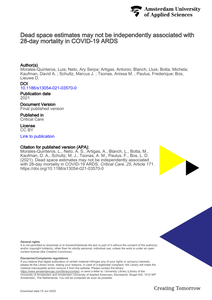BACKGROUND: Estimates for dead space ventilation have been shown to be independently associated with an increased risk of mortality in the acute respiratory distress syndrome and small case series of COVID-19-related ARDS.METHODS: Secondary analysis from the PRoVENT-COVID study. The PRoVENT-COVID is a national, multicenter, retrospective observational study done at 22 intensive care units in the Netherlands. Consecutive patients aged at least 18 years were eligible for participation if they had received invasive ventilation for COVID-19 at a participating ICU during the first month of the national outbreak in the Netherlands. The aim was to quantify the dynamics and determine the prognostic value of surrogate markers of wasted ventilation in patients with COVID-19-related ARDS.RESULTS: A total of 927 consecutive patients admitted with COVID-19-related ARDS were included in this study. Estimations of wasted ventilation such as the estimated dead space fraction (by Harris-Benedict and direct method) and ventilatory ratio were significantly higher in non-survivors than survivors at baseline and during the following days of mechanical ventilation (p < 0.001). The end-tidal-to-arterial PCO2 ratio was lower in non-survivors than in survivors (p < 0.001). As ARDS severity increased, mortality increased with successive tertiles of dead space fraction by Harris-Benedict and by direct estimation, and with an increase in the VR. The same trend was observed with decreased levels in the tertiles for the end-tidal-to-arterial PCO2 ratio. After adjustment for a base risk model that included chronic comorbidities and ventilation- and oxygenation-parameters, none of the dead space estimates measured at the start of ventilation or the following days were significantly associated with 28-day mortality.CONCLUSIONS: There is significant impairment of ventilation in the early course of COVID-19-related ARDS but quantification of this impairment does not add prognostic information when added to a baseline risk model.TRIAL REGISTRATION: ISRCTN04346342. Registered 15 April 2020. Retrospectively registered.
MULTIFILE

Objectives Patients who underwent corrective surgery for tetralogy of Fallot (TOF) have increased long-term risk of cardiovascular morbidity and mortality. Yet, limited information is available on how to evaluate the risk in this population. Therefore, the aim of this study was to investigate the prognostic value of aerobic exercise capacity, along with other related parameters, at medium-term follow-up in adult patients with tetralogy of Fallot. Methods and results Between 2000 and 2003, 92 adults (age 26.2 ± 7.8 years; 63 male) with corrected TOF or TOF-type morphology underwent a cardiopulmonary exercise test (CPET) until exhaustion and echocardiography. During a mean follow-up of 7.3 ± 1.2 years (range 0.9 to 9.3 years), 2 patients died and 26 patients required at least 1 cardiac-related intervention at a mean age of 28.9 ± 7.9 years. Event-free survival tended to be higher in patients with the classical type of TOF (P = 0.061). At multivariate Cox analysis, age at CPET [hazard ratio (HR): 1.13, P = 0.006], age at correction (HR: 0.82, P = 0.037), right ventricular (RV) function (HR: 4.94, P = 0.001), QRS duration (HR: 1.02, P = 0.007), percentage of predicted peak oxygen uptake (peak VO2%) (HR: 0.96, P = 0.029) and ventilatory effi ciency slope (VE/VCO2 slope) (HR: 1.13, P = 0.021) were signifi cantly related to the incidence of death/cardiac-related intervention during medium follow-up. Conclusions Early corrective surgery and a well-preserved RV are associated with a better outcome in adults with corrected TOF. Furthermore, CPET provides important prognostic information; peak VO2% and VE/VCO2 slope are independent predictors for event-free survival in patients with corrected TOF.
DOCUMENT

From an evidence-based perspective, cardiopulmonary exercise testing (CPX) is a well-supported assessment technique in both the United States (US) and Europe. The combination of standard exercise testing (ET) (ie, progressive exercise provocation in association with serial electrocardiograms [ECG], hemodynamics, oxygen saturation, and subjective symptoms) and measurement of ventilatory gas exchange amounts to a superior method to: 1) accurately quantify cardiorespiratory fitness (CRF), 2) delineate the physiologic system(s) underlying exercise responses, which can be applied as a means to identify the exercise-limiting pathophysiologic mechanism(s) and/or performance differences, and 3) formulate function-based prognostic stratification. Cardiopulmonary ET certainly carries an additional cost as well as competency requirements and is not an essential component of evaluation in all patient populations. However, there are several conditions of confirmed, suspected, or unknown etiology where the data gained from this form of ET is highly valuable in terms of clinical decision making
DOCUMENT
